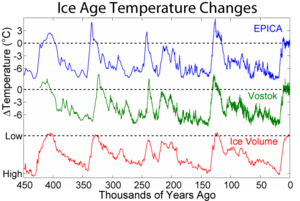Interglacial
This article relies largely or entirely on a single source. (December 2010) |

An interglacial period (or alternatively interglacial, interglaciation) is a geological interval of warmer global average temperature lasting thousands of years that separates consecutive glacial periods within an ice age. The current Holocene interglacial began at the end of the Pleistocene, about 11,700 years ago.
Pleistocene
During the 2.5 million years of the Pleistocene, numerous glacials, or significant advances of continental ice sheets, in North America and Europe, occurred at intervals of approximately 40,000 to 100,000 years. The long glacial periods were separated by more temperate and shorter interglacials.
During interglacials, such as the present one, the climate warms and the
Interglacials and glacials coincide with cyclic changes in
In the Southern Hemisphere, warmer summers occur when the lower-half of Earth is tilted toward the Sun and the planet is nearest the Sun in its elliptical orbit. Cooler summers occur when Earth is farthest from the Sun during the Southern Hemisphere summer. Such effects are more pronounced when the eccentricity of the orbit is large. When the obliquity is large, seasonal changes are more extreme.[2]
Interglacials are a useful tool for geological mapping and for anthropologists, as they can be used as a dating method for
Brief periods of milder climate that occurred during the last glacial are called
The
An interglacial optimum, or climatic optimum of an interglacial, is the period within an interglacial that experienced the most 'favourable'
Specific interglacials
The last six interglacials are:
- Marine Isotope Stage 13 (524–474 thousand years ago).
- Holstein / Mindel-Riss / Marine Isotope Stage 11(424–374 thousand years ago).
- Purfleet Interglacial / Marine Isotope Stage 9(337–300 thousand years ago).
- La Bouchet Interglacial / Arousa Interglacial / Aveley Interglacial / Marine Isotope Stage 7e (242–230 thousand years ago). MIS 7a, MIS 7b and MIS 7c may or may not be included. MIS 7d was a cold period dividing the MIS 7 interglacial into two distinct periods. MIS 7e contained the climatic optimum.
- was about 2 °C higher than at present.
- Atlanticum (9 to 5 ka, which corresponds to roughly 7000 BC–3000 BC). The current climatic phase following this climatic optimum is still within the same interglacial (the Holocene). That warm period was followed by a gradual decline until about 2000 years ago, with another warm period until the Little Ice Age(1250–1850).
See also
- Greenhouse and icehouse Earth
- Milankovitch cycles
- Snowball Earth
- Interstadial periods
- Last glacial maximum
- Timeline of glaciation
References
- ^ Eldredge, S. "Ice Ages – What are they and what causes them?". Utah Geological Survey. Retrieved 2 March 2013.
- ^ Rieke, G. "Long Term Climate".
- ISBN 978-0-07-289028-0.
- S2CID 10676558. Retrieved 20 Dec 2018.
